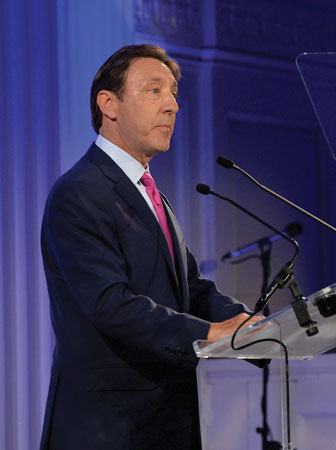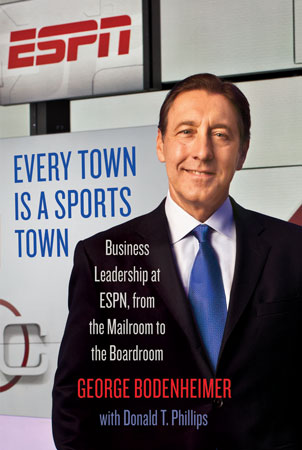Steve Jobs was standing over at the coffee bar. It was about fifteen minutes before the start of The Walt Disney Company’s spring board meeting in Orlando in March 2006.
Two months earlier, in one of Bob Iger’s first initiatives as CEO, Disney had purchased Pixar Animation Studios at a cost of $7.4 billion, which made Jobs (Pixar’s CEO and majority owner) Disney’s largest shareholder. It was Steve’s first meeting as a new member of the board of directors.
I was attending, because two years earlier I had been named co-chairman, Disney Media Networks (along with Disney/ABC Television Group President Anne Sweeney), and was often invited to attend board meetings.
Of course, I was very familiar with Steve Jobs, but we had never met. So I figured this would be a good time to go up, get a cup of coffee, and introduce myself. “Good morning, Steve. How are you,” I said. “I’m George Bodenheimer, with ESPN.”
Steve finished stirring his coffee, looked up at me, and said, “I hate your phone.” Then he walked away.
ESPN had just launched a mobile phone with a lot of fanfare, including purchasing a thirty-second Super Bowl ad for $2.5 million as part of our massive introductory advertising campaign. We called our phone “The MVP.” It was a Sanyo flip model with a retro look (black with red buttons). I didn’t know if Steve meant he didn’t like the look of our phone or the idea of it. Maybe he meant both. The idea was to create a phone for sports fans with instant access to scores and breaking news. Our business model was both aggressive and creative. Customer contracts, care, and other services were to be managed directly by us. We projected sales on the order of 500,000 phones with a break-even point of about 250,000. Given the enthusiasm of sports fans and their growing interest in accessing up-to-the-minute sports news and scores, we were confident we could achieve these numbers.
 |
Photo by: GETTY IMAGES
|
Everything would have been great if the phone had sold, but it didn’t. In eight months, we moved only thirty thousand units. Not surprisingly, in October 2006 my boss, Bob Iger, called me. “George, what are we doing here?” he said. “We’re really under projections. It’s not going to work. Let’s cut our losses sooner rather than later.”
Both Iger and Jobs were right. So despite all the publicity and all the upfront money we had spent, ESPN pulled the plug on the MVP phone. …
Part of Iger’s new direction for Disney and ESPN was to rapidly embrace technology. And I wanted to get out in front of the competition and be the first cable network to truly serve its customers by embracing multimedia. Unfortunately, our strategy and business plan to begin with a mobile phone were flawed.
{podcast}
SBJ Podcast:
Media writer John Ourand and Executive Editor Abraham Madkour discuss the ad sales market and what its current "soft" status means for sports.
Despite our success over the years, ESPN had also tried many things that didn’t work. For example, ESPN2 played rock music, and that didn’t pan out. ESPN retail stores weren’t profitable, so we closed them. In 2010, ESPN created the first 3-D television network. We shut it down in 2013. …
Risk taking had always been a part of ESPN’s culture, and I believe it had been an important catalyst for our success over the years. But when you take risks, you are sometimes going to have setbacks. It is how a company handles those setbacks that determines whether or not it will be successful in the long run.
Another part of ESPN’s culture has always been to take advantage of mistakes by learning from them. Executives sometimes hang on to unsuccessful initiatives too long because they’re afraid to admit they were wrong. In the case of the ESPN phone, we tried it, it didn’t work out, so we made a quick correction. I heard Bob Iger say it frequently: “Pack light and travel fast.”

So I assembled the “MVP” phone group, laid out the facts, thanked everyone for all their hard work, and told them that we had to shift gears and develop a new strategy for entering the mobile market. That effort was led by a large team, which included John Zehr, who had joined ESPN back in 1993 during our partnership with Starwave to create our first Internet site. So, in essence, all the talented people who created the ESPN phone worked together to develop a Plan B for ESPN mobile. And it paid off, too, because between 2006 and 2012, ESPN more than doubled its cross-platform audience. …
Looking back on it, I can say that I never really did consider the ESPN phone a failure. Rather, it was our first step on the road to success in the mobile market. ESPN was not bulletproof — and the day we thought we were would be the day our company started a downhill slide. We made a mistake, learned from it, and moved on. Once we revised our strategy and tweaked the business model, everything we employed to create the phone was put to good use. I’m proud to say that, by 2014, ESPN was setting all-time records for the number of sports fans using ESPN mobile, nearly fifty million per month. And that was no accident. It was the result of good, solid teamwork and group leadership.
Through the years, I was often asked to state ESPN’s business strategy. My response was pretty simple. “Well, we try a lot of things,” I’d reply. “The things that don’t work, we stop doing. And the things that do work, we keep improving in order to make them the best we can. That’s our strategy.”
More specifically, I was also asked how ESPN successfully transformed itself from a television company to a multimedia company. The answer, in part, is that we adhered to three main business principles: (1) be first to market; (2) do not fear cannibalization of your existing business; and (3) stay true to your brand and your mission. The keys to expanding into multimedia are really no more complicated than that.






